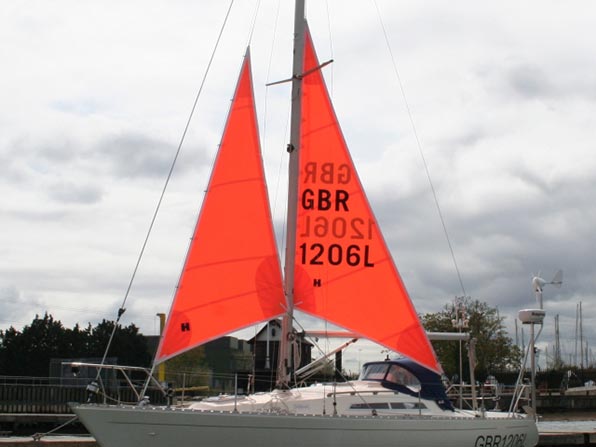Try and try again
As a followup to yesterday’s post about sail covers, several people commented that the extra windage of the stack pack may be detrimental in the strong winds of Patagonia. While I didn’t mention it in my abbreviated post, that did not elude me. Also related to the strong wind scenario, one other potential negative to having a stack pack with integral lazy jacks is that it could be more difficult to rig a storm trysail, or, at least it seems that way to me.

To tell the truth though, I’ve never rigged one of those sails, nor do I have one to test my theory. I’m basing my assumption on photos and videos which show the loose fitted sail being controlled independent of the boom, sheeted through turning blocks rigged aft on the boat. Perhaps someone reading this might be able to add some clarity to this. If I’m not mistaken, our friend Miles, who sailed around Cape Horn on his beautiful ketch Lonestar, said that he used his trysail often.
Of course, there are always options…



Wonderful. I sailed with Skip from Monte Carlo to Seychelles on a Swan 65 many years ago.
I have a question: Why do we even try to use storm trysails? Surely that extra reef is better or in the case of roller furling just take it down to a manageable size?
Or in the case of ketch rig use reefed mizzen and small inner jib.
Id be pleased to see any comments.
Lin, you are making the assumption that your mainsail and the boom are still in working conditions…
In really bad conditions when offshore, it is usually safer to remove the mainsail altogether and use the trysail. A proper trysail is usually cut to be sheeted independent of the boom in car the boom is damaged/missing. It’s also a good idea to consider mounting a separate track on the mast to hoist the trysail if the mainsail is still mounted on the main track.
Part of the reason the foot of storm sails is cut so high is to keep the bottom of the sail
from getting hit by waves that could either getting damage the sail and/rigging, or destabilizing the boat.
Thats what I was taught anyway, admittedly I have not had to use a storm sail in real
conditions.
I’m certainly not going to argue with a guy like Skip Novak. He has been there, done that.
I’m no expert, and have never hoisted a storm sail, but these are the two answers I’ve been given when I asked the same question:
Roller furling still has a minimum size, if you make your sail any smaller it will bend or break your furling gear. This is because a smaller sail focuses the strain on a smaller portion of the gear, especially in high winds.
Super-reefed mainsails still sit on the boom, which puts the center of effort of the sail in a different place. Look at the trysail in the picture — it’s designed to have the center of effort further aft and a little further up. I can’t tell you why that’s a good thing, but I’m assured that it is such a good thing that it’s the entire point of the sail’s shape.
Also, these storm sails are often designed much more durably than your regular sails, which have to mix high-wind strength with low-wind performance.
Hope that helps, it’s what I’ve been told. 🙂
Yes, a storm sail should be much heavier than a typical main.
oops, my previous comment was in reply to Kevin regarding the shape of the storm sails, not Guy.
🙂
Whatever storm sail strategy you come up with, I recommend that you DO NOT figure on removing any sails. I’ve sailed in 50+ knots and I do not want to be on the deck unless I have to and I definitely do NOT want to be removing any sails. We have a 100% high cut jib and a staysail, both on furlers. I have a very deep 3rd reef cut in the fully battened main. I’m hoping that is enough. I believe that the stormsail strategy is to use a sail that is independent of the boom. If you can get the mainsail off the boom and stowed before the wind picks up, thats great, but I wouldn’t count on it. By the way, I’ve actually met a few cruisers who have broken their boom in high winds and seas.
I wouldn’t count on removing sail either!
Do you have a staysail? An 8 oz staysail on your boat will take anything that will come your way.
I ran with my staysail (Corbin 39) for about 2 days once in 40+ winds. But you won’t be going anywhere too fast, or at all, on a close reach. Works great on most other points of sail and the low center of gravity keeps heeling down to a minimum.
I like the Novak’s idea of a 4th reef, if your 3rd reef is still too big. Like Novak said, setting up the storm sail in big seas is asking for trouble. People who think working on deck in 25’+ waves is a matter of being strong and fit have never been in those conditions. I have all my lines (17) going to the cockpit and never regretted it.
As for concerns about a busted/damaged boom or mainsail…if that happens because you didn’t reef early enough, a trysail may be good as a last resort.
Cheers
We do not have all lines led to the cockpit and I’m happy with that arrangement. There is much less friction in the system. Of course, if you’re going to be moving about the boat, a proper system of tethering to jack lines is necessary (subject for future posts).
Or do you skip the tri sail and rely on a deeply reefed main?
While I have no experience is sustained high winds, like Wade I wouldn’t relish taking the main below in gale, in preparation for a storm. I’ve had 3rd reefs in my last 2 mains, and a 4th wouldn’t be crazy. I never left the tackle rigged for the deeper reefs.
As for busted sails and booms, with a ketch you have options.
Just thoughts. I’d talk with several sailmakers.
Like the ones on most boats, I suspect, our boom has room for the outhaul and three reefing lines. I guess to use the fourth reef you’d untie the first and re-tie it through the fourth reefing cringle? If so, that seems sketchy to me too.
You can always skip the first reef. That’s what I did.
It’s not that important compared to the 2nd, 3rd or 4th. The first reef is more of a comfort factor than a safety factor.
That’s one way of looking at it. Or use the outhaul as the first reef line. We find that we almost always have a reef in!
We have a main with a reef that makes it the size of a trysail. Have used that reef a number of times. We have sailed a couple of times in winds 70-80 kt. In those conditions we only use a storm jib, no main.
If you stop by we can show you some pics.
Sailed 8 days with the third reef in the main, storm jib and a little handkerchief of headsail poled out when we had 35-50 kt sailing from Cape Verde towards Brazil.
The job of the storm jib was to stabilize the boat and prevent it from rolling.
We definitely need to get together before you guys take off.